Something Eating Bean Foliage Before it Emerges?
mwieder
15 years ago
Related Stories

GARDENING GUIDES8 Plants Bursting With Beautiful Fall Foliage
Luscious berries, rich crimson leaves and stellar stalks show that nary a flower is needed for enthralling autumn gardens
Full Story
SUMMER FRUITS AND VEGETABLESSummer Crops: How to Grow Beans
Grow your own beans for amazing variety and healthy, convenient produce all summer
Full Story
LIFEYour First-Aid, Emergency and Medical Supply Checklist
Don’t wait until you need them to stock your first-aid kit and emergency stash. Here’s what to get and where to keep it
Full Story
GARDENING GUIDES7 New Plants to Grow for Beautiful Foliage
Add color, structure and interest to your garden with these recently introduced plants that sport exceptional foliage
Full Story
FARM YOUR YARD6 Things to Know Before You Start Growing Your Own Food
It takes time and practice, but growing edibles in the suburbs or city is possible with smart prep and patience
Full Story
CONTRACTOR TIPS10 Things to Discuss With Your Contractor Before Work Starts
Have a meeting a week before hammers and shovels fly to make sure everyone’s on the same page
Full Story
FRONT YARD IDEASBefore and After: Front Lawn to Prairie Garden
How they did it: Homeowners create a plan, stick to it and keep the neighbors (and wildlife) in mind
Full Story
HOUSEKEEPINGDon't Touch Another Stain Before You Read This
Even an innocent swipe with water may cause permanent damage. Here's what to know about how rugs and fabrics react
Full Story
WHITEWhat to Know Before You Paint Your Walls White
A coat of white paint can do wonders in one room and wreak havoc in another. Here are tips for using the popular hue
Full Story
GARDENING GUIDESGreat Golden Digger Wasp: A Beneficial Flower-Visiting Insect
Introducing the great golden digger wasp, a colorful pollinator that also hunts foliage-eating insects
Full Story





galina
rosefenn
Related Professionals
Ballwin Landscape Architects & Landscape Designers · Alamo Landscape Contractors · Belmont Landscape Contractors · Cockeysville Landscape Contractors · Concord Landscape Contractors · Estelle Landscape Contractors · Lancaster Landscape Contractors · Melrose Landscape Contractors · Paramount Landscape Contractors · Paramus Landscape Contractors · Royal Oak Landscape Contractors · Siloam Springs Landscape Contractors · Baltimore Decks, Patios & Outdoor Enclosures · Salt Lake City Decks, Patios & Outdoor Enclosures · Vero Beach Decks, Patios & Outdoor Enclosuresjimster
galina
zeedman Zone 5 Wisconsin